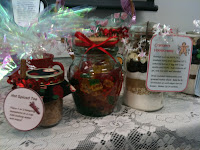 Our LIFE class this week got a special treat; chicken soup! World renowned for its healing properties, chicken soup is a good remedy for many upper respiratory tract illnesses. Librarians Elise Sheppard and Jill Vu joined us to give us the Jewish and Vietnamese takes on this classic fare. Recipes below. Also below is a link explaining why chicken soup is so good for you. Our LIFE class left feeling fuller in wisdom and healthy goodness. Feel free to try one of these recipes at home with your family the next time cold and flu season comes around, or any day the week for a hearty and healthy meal.
Our LIFE class this week got a special treat; chicken soup! World renowned for its healing properties, chicken soup is a good remedy for many upper respiratory tract illnesses. Librarians Elise Sheppard and Jill Vu joined us to give us the Jewish and Vietnamese takes on this classic fare. Recipes below. Also below is a link explaining why chicken soup is so good for you. Our LIFE class left feeling fuller in wisdom and healthy goodness. Feel free to try one of these recipes at home with your family the next time cold and flu season comes around, or any day the week for a hearty and healthy meal.Jewish Chicken Soup - AKA Jewish Penicillin
Rosely Himmelstein's winning recipe from Shabbat Across America's Chicken Soup Challenge
http://www.worldfamousrecipes.com/chicken-soup-winner.html
(Serves about 6)
Ingredients
•2 quarts of chicken broth (the recipe follows)
•1 chicken (about 3-4 lbs), quartered (I prefer a regular chicken to a fowl); rinsed
•1 large carrot, peeled and cup up
•1 large onion, peeled and cup up
•1 stalk celery
•1 leek, white and light green parts only; washed well
•1 parsnip, peeled and cut up
•1 parsley root, with greens attached
•1 sweet potato, peeled
•a handful of dill (about 3-4 stems)
•1 small rutabaga, peeled and cut up
•a few sprigs of cilantro (optional)
•Salt and pepper to taste
Directions:
•Put chicken broth in pot; bring to boil.
•Add chicken. Return to boil; lower heat.
•Gently simmer uncovered for 1 hour.
•Add the rest of the ingredients. Simmer for one-half hour more; stir occasionally.
•Skim fat from top.
•Pour into bowls; into each add a slice of carrot and a sprig of cilantro.
•If storing, let soup cool before refrigerating. When cold, remove the fat that rises to the surface. Use soup within 2-3 days, or store in freezer.
Vietnamese Chicken Soup
Ingredients:
•2 tbsp tamarind powder (optional)
•1/4 cup thinly sliced shallots
•1 tbsp oil
•1/2 tsp minced garlic
•1/2 tsp Asian chili paste or hot chili flakes
•5 cups fat-skimmed chicken broth
•1 lb chicken (or fish/shrimp)
•1 cup pineapple chunks
•2 tbsp Asian fish saucs (nuoc mam)
•3 tbsp sugar
•1/4 cup lime juice (6 tbsp if you don't use tamarind powder)
•2 tomatoes (6 oz. total) rinsed and cut into 1/2 inch wedges
•2 celery stalks or taro steam (sliced)
•2 cups (6 oz.) bean sprouts, rinsed and drained
•2 tbsp chopped fresh basil leaves
•2 tbsp chopped rice-paddy herb (ngo om) or fresh cilantro
•2 tsp finely chopped fresh chilies or chili garlic sauce
Directions:
•In a 5 to 6 quart pan over medium heat, stir shallots with oil until golden brown and crisp.
•Add garlic, chicken, and fish sauce to pan and stir until garlic is fragrant.
•Add broth, tamarind powder, sugar and bring to a boil over high heat.
•Add pineapple, tomatoes, and celery or taro steam.
•Cook uncovered just until chicken is cooked and simmered, 5-6 minutes.
•Add bean sprouts into hot broth.
•Ladle soup mixture into bowls and sprinkle with fried shallots, cilantro, basil, rice-paddy herb (ngo om) and chopped green onions. Add chilies to taste.
For more information on the therapeutic properties of chicken soup, go to http://chestjournal.chestpubs.org/content/118/4/1150.full.html

















 Ni hao, LIFEers! (That is "hello" in Mandarin.) This week our intrepid class traveled back in time (metaphorically speaking) to ancient China with the help of Professor Bobby O'Brien to learn all about the facts and fiction of The Great Wall of China.
Ni hao, LIFEers! (That is "hello" in Mandarin.) This week our intrepid class traveled back in time (metaphorically speaking) to ancient China with the help of Professor Bobby O'Brien to learn all about the facts and fiction of The Great Wall of China.















 The artists Mary Cassatt and Edgar Degas disagreed about style. Degas believed a good painting needed a pretty subject. Cassatt believed that composition was most important and to prove her point, she composed a painting of a servant girl at her toilette, titled Girl Arranging Her Hair. The model is not a classical beauty by any means, but the painting is fascinating none the less. The beauty of the picture comes from the rigor of the composition, the angles of the girls arms and braid to the furniture behind her, and the gentle contrast of colors. Degas conceded the point.
The artists Mary Cassatt and Edgar Degas disagreed about style. Degas believed a good painting needed a pretty subject. Cassatt believed that composition was most important and to prove her point, she composed a painting of a servant girl at her toilette, titled Girl Arranging Her Hair. The model is not a classical beauty by any means, but the painting is fascinating none the less. The beauty of the picture comes from the rigor of the composition, the angles of the girls arms and braid to the furniture behind her, and the gentle contrast of colors. Degas conceded the point.














